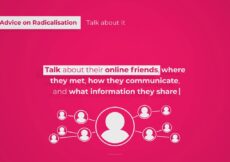Preparing kids for the future means engaging them in STEM now.

STEM permeates every aspect of our lives—and it will only increase in importance. “Science, technology, engineering and math are central to understanding a world that is changing as quickly as ours,” says Johanna Busch, Toronto-based Education Specialist for Let’s Talk Science. The Canadian charitable organization helps kids prepare for the future by supporting STEM learning. “We all need a basic level of understanding of STEM concepts to make sense of everything from pandemics to climate change. STEM is crucial to our ability to be informed citizens and to meet challenges in our careers and beyond.”
“All jobs are being reshaped by technology, and STEM innovation will define many future jobs—including ones that don’t even exist yet,” adds Let’s Talk Science President and Founder, Bonnie Schmidt.
It’s important for kids to get excited about STEM from an early age—not only so they can pursue STEM careers for their own success, but to meet the changing needs of our world. And, it’s particularly critical for underrepresented groups like girls and people of colour to receive the support they need to succeed in STEM fields. So how do we engage young people in STEM?
Start with your kids’ interests
“Ask kids what they are interested in and follow their lead,” says Busch. “Kids come alive when they realize that STEM provides them with the tools and frameworks to explore topics that they are already curious about.” Help them figure out how STEM plays a role in things they care about whether it’s the coding of their favourite video game or the mathematical aspects of music, such as tempo and rhythm. Then explore how STEM can further these interests.
Model joy in STEM exploration
“Kids are innately interested in their world,” says Schmidt. “Adults who show a genuine interest in exploring, asking questions and playing with materials (including gardening, meal prep and building) are the most effective STEM role models.” Include your kids in hands-on activities you’re already doing. It’s a great way to build interest and excitement. “Showcase fun STEM-related things as you go about your regular day,” suggests Schmidt. “Marvel at the technology at the grocery store checkout, mention how water and light form beautiful rainbows or discuss chemical reactions needed to make a cake.” These conversations help kids see the STEM concepts that surround them in everyday life.
Use STEM words early and often
Use words related to STEM from when your kids are really young. Point out how things involve science, technology, engineering or math. “This helps them build comfort and a sense that STEM is ‘for them’”, says Schmidt. “Anyone who has talked about dinosaurs with a preschooler understands their amazing capacity for vocabulary and their excitement in using new words. The early years are an important time to foster their science identity.”
Share STEM stories
Talk about STEM innovations, how they help us and who created them. Pay attention to the role models you share because historically, STEM stories have mainly focused on white men. Avoid language that reinforces stereotypes of who can work in STEM. All kids need to be able to see themselves represented in what they are learning.
Keep it simple
If your child is curious about how plants grow, don’t immediately start with complex words like photosynthesis. Focus on what they already know and questions they have. Introduce complicated terms as they learn more about a concept and can start to explain it in their own words. This helps them focus on understanding first, making it easier to incorporate new words without feeling overwhelmed.
A great place for resources is Let’s Talk Science’s free programming, such as its list of hands-on activities. It’s never too soon to get kids excited about STEM.
Stay in touch
Subscribe to Today’s Parent’s daily newsletter for our best parenting news, tips, essays and recipes.
= 0;if(!is_postback){return;}var form_content = jQuery(this).contents().find(‘#gform_wrapper_13’);var is_confirmation = jQuery(this).contents().find(‘#gform_confirmation_wrapper_13’).length > 0;var is_redirect = contents.indexOf(‘gformRedirect(){‘) >= 0;var is_form = form_content.length > 0 && ! is_redirect && ! is_confirmation;var mt = parseInt(jQuery(‘html’).css(‘margin-top’), 10) + parseInt(jQuery(‘body’).css(‘margin-top’), 10) + 100;if(is_form){jQuery(‘#gform_wrapper_13’).html(form_content.html());if(form_content.hasClass(‘gform_validation_error’)){jQuery(‘#gform_wrapper_13’).addClass(‘gform_validation_error’);} else {jQuery(‘#gform_wrapper_13’).removeClass(‘gform_validation_error’);}setTimeout( function() { /* delay the scroll by 50 milliseconds to fix a bug in chrome */ jQuery(document).scrollTop(jQuery(‘#gform_wrapper_13’).offset().top – mt); }, 50 );if(window[‘gformInitDatepicker’]) {gformInitDatepicker();}if(window[‘gformInitPriceFields’]) {gformInitPriceFields();}var current_page = jQuery(‘#gform_source_page_number_13’).val();gformInitSpinner( 13, ‘https://www.todaysparent.com/wp-content/plugins/gravityforms/images/spinner.gif’ );jQuery(document).trigger(‘gform_page_loaded’, [13, current_page]);window[‘gf_submitting_13’] = false;}else if(!is_redirect){var confirmation_content = jQuery(this).contents().find(‘.GF_AJAX_POSTBACK’).html();if(!confirmation_content){confirmation_content = contents;}setTimeout(function(){jQuery(‘#gform_wrapper_13’).replaceWith(confirmation_content);jQuery(document).scrollTop(jQuery(‘#gf_13’).offset().top – mt);jQuery(document).trigger(‘gform_confirmation_loaded’, [13]);window[‘gf_submitting_13’] = false;}, 50);}else{jQuery(‘#gform_13’).append(contents);if(window[‘gformRedirect’]) {gformRedirect();}}jQuery(document).trigger(‘gform_post_render’, [13, current_page]);} );} );]]>
Read The Full Article Here



































